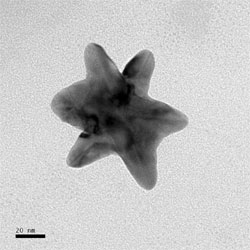Home > Press > 'Nanostars' Could Be Ultra-sensitive Chemical Sensors
Abstract:
Scientists Observe Strong Spectral Signals From Spikes On Gold Particles
'Nanostars' Could Be Ultra-sensitive Chemical Sensors
Houston, TX | Posted on April 18, 2006
New optics research from Rice University's
Laboratory for Nanophotonics suggests that tiny gold particles called
nanostars could become powerful chemical sensors.
The findings are available online and due to appear in an upcoming issue of
the journal Nano Letters.
Nanophotonics is a rapidly growing field of study that looks at ways to
generate and manipulate light using ultrasmall, engineered structures. The
virus-sized nanostars, so named because of their spiky surface, are one of a
growing number of intricately shaped particles that are increasingly drawing
the attention of experts at LANP and other leading photonics labs.
"Just a few years ago, everyone's attention was on the size of nanoparticles
because altering size was a straightforward way to change the wavelength of
light that the particle reacted with," said lead researcher Jason Hafner,
associate director of LANP and assistant professor of physics and astronomy
and of chemistry. "Today, researchers are increasingly interested in
intricate shapes and the specific ways that those shapes affect a particle¹s
interaction with light."
Most nanophotonic research at LANP involves the study of plasmons, waves of
electrons that flow like a fluid across metal surfaces. Light can be used to
amplify plasmon waves on metal nanoparticles. Like a child in a bathtub,
rhythmically building waves until they slosh out of the tub, the plasmons on
the particles dramatically amplified with wavelengths of light that
correspond to the rhythm of the electron waves. The study of plasmonics is
one of the fastest growing fields in optics because it could prove useful
for a wide range of applications in biological sensing, microelectronics,
chemical detection, medical technology and others.
"LANP is building a broad-based plasmonics research program at Rice, and our
recent cutting-edge work on novel structures like nanostars and nanorice is
a clear indication of leadership we're building in this field," said LANP
Director Naomi Halas, the Stanley C. Moore Professor of Electrical and
Computer Engineering and professor of chemistry.
Nanostars incorporate some of the best properties of oft-studied photonic
particles like nanorods and quantum dots. For example, they deliver strong
spectral peaks that are easy to distinguish with relatively low-cost
detectors. But Hafner's team found unique properties too. A painstaking
analysis revealed that each spike on a nanostar has a unique spectral
signature, and preliminary tests show that these signatures can be used to
discern the three-dimensional orientation of the nanostar, which could open
up new possibilities for 3-D molecular sensing.
"We are just getting started with our follow-up work, but nanostars clearly
offer some exciting possibilities," said Hafner, assistant professor of
physics and astronomy and of chemistry. "Their extreme sensitivity to the
local dielectric environment is a particularly attractive quality for
molecular sensing."
Co-authors of the study include physics and astronomy graduate student
Colleen Nehl and chemistry graduate student Hongwei Liao. The research was
supported by the Army Research Office, the National Science Foundation and
the Welch Foundation.
About Rice University:
Rice University is consistently ranked one of America's best teaching and research universities. It is distinguished by its: size: 2,850 undergraduates and 1,950 graduate students; selectivity: 10 applicants for each place in the freshman class; resources: an undergraduate student-to-faculty ratio of 6-to-1, and the fifth largest endowment per student among American universities; residential college system, which builds communities that are both close-knit and diverse; and collaborative culture, which crosses disciplines, integrates teaching and research, and intermingles undergraduate and graduate work. Rice's wooded campus is located in the nation's fourth largest city and on America's South Coast.
For more information, please click here
Contact:Jade Boyd
(713) 348-6778
jadeboyd@rice.edu
Copyright © Rice University
If you have a comment, please Contact us.
Issuers of news releases, not 7th Wave, Inc. or Nanotechnology Now, are solely responsible for the accuracy of the content.
| Related News Press |
Possible Futures
![]() Discovery points path to flash-like memory for storing qubits: Rice find could hasten development of nonvolatile quantum memory April 5th, 2024
Discovery points path to flash-like memory for storing qubits: Rice find could hasten development of nonvolatile quantum memory April 5th, 2024
![]() With VECSELs towards the quantum internet Fraunhofer: IAF achieves record output power with VECSEL for quantum frequency converters April 5th, 2024
With VECSELs towards the quantum internet Fraunhofer: IAF achieves record output power with VECSEL for quantum frequency converters April 5th, 2024
Sensors
Materials/Metamaterials/Magnetoresistance
![]() Nanoscale CL thermometry with lanthanide-doped heavy-metal oxide in TEM March 8th, 2024
Nanoscale CL thermometry with lanthanide-doped heavy-metal oxide in TEM March 8th, 2024
![]() Focused ion beam technology: A single tool for a wide range of applications January 12th, 2024
Focused ion beam technology: A single tool for a wide range of applications January 12th, 2024
Announcements
![]() NRL charters Navy’s quantum inertial navigation path to reduce drift April 5th, 2024
NRL charters Navy’s quantum inertial navigation path to reduce drift April 5th, 2024
![]() Discovery points path to flash-like memory for storing qubits: Rice find could hasten development of nonvolatile quantum memory April 5th, 2024
Discovery points path to flash-like memory for storing qubits: Rice find could hasten development of nonvolatile quantum memory April 5th, 2024
|
|
||
|
|
||
| The latest news from around the world, FREE | ||
|
|
||
|
|
||
| Premium Products | ||
|
|
||
|
Only the news you want to read!
Learn More |
||
|
|
||
|
Full-service, expert consulting
Learn More |
||
|
|
||









